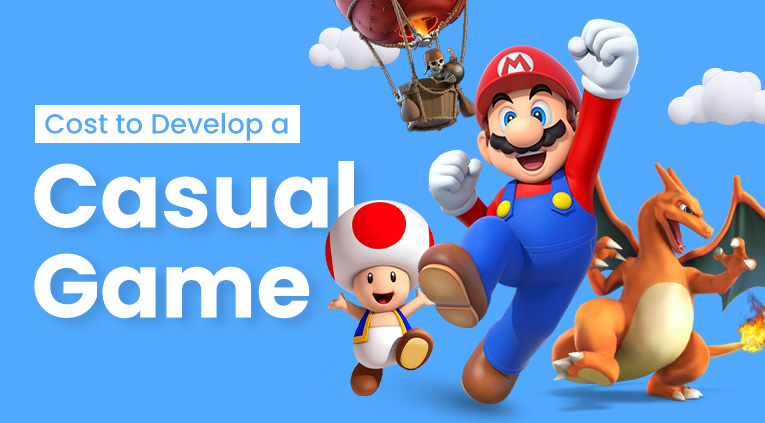The trend and demand for mobile game development are rising in 2024, and many developers are turning to the development of arcade games. But with any game project, comes a range of costs that will need to be taken into consideration.
When planning to develop an arcade game, there are several key cost factors that must be identified and addressed. Whether you’re an entrepreneur or a business and planning to build a custom arcade game or a mobile game, you’ll need to invest in the technologies and resources necessary for the development process.
This article will explore what costs to consider when developing an arcade game and how you can best manage these expenses. Along with this, we will also explore the overall game development process.
Let’s begin with some arcade game statistics.
Arcade Game Statistics
1. According to reports, the global arcade game market was valued at around $3678 million in 2021, and it’s all set to touch the mark of $5476 million by 2029 end.
2. During 2022 and 2027, the arcade gaming market is growing at a CAGR of 1.99%, which indicates the growing interest of users in these games.
Looking at the statistics, it’s clear that hiring an arcade game development team will bring in the desired results. But to make sure your arcade game development project is a success, you’ll need to first understand the cost and the working process of it. On this note, let’s look at the benefits of building a custom arcade game.
Benefits of Developing an Arcade Game
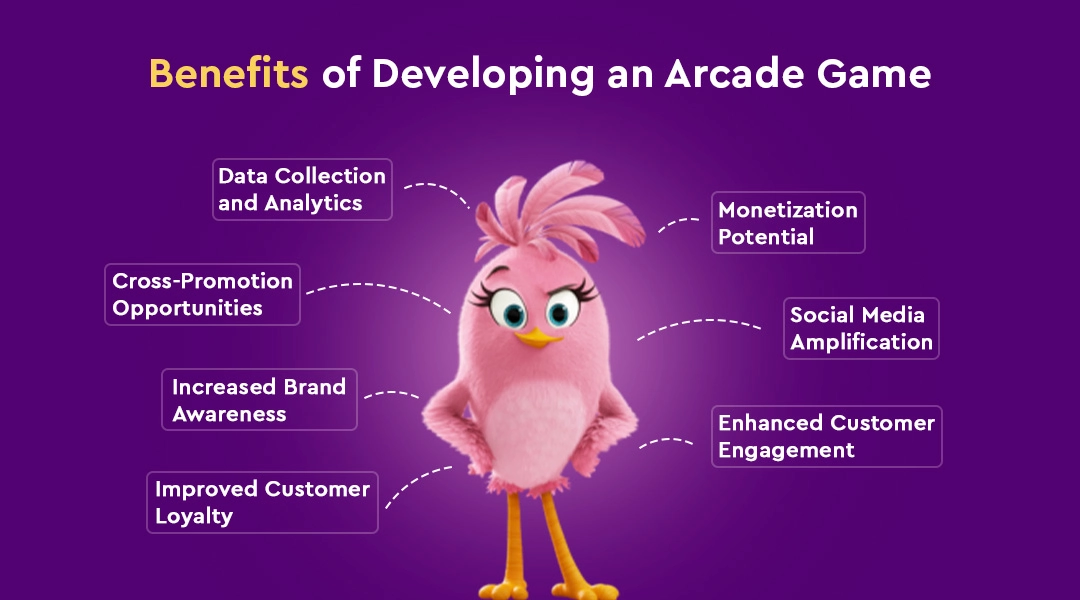
1. Data Collection and Analytics
Developing an arcade game presents an excellent opportunity for businesses to collect valuable customer data. Through in-game surveys, feedback forms, or user profiles, companies can gain insights into user preferences, behaviors, and demographics. This data can then be utilized to refine marketing strategies, personalize offerings, and make informed business decisions.
2. Monetization Potential
Arcade games offer various monetization avenues, providing businesses with an additional revenue stream. In-game advertisements, sponsorships, in-app purchases, and premium upgrades are just a few examples of how companies can generate income from their arcade games. By carefully balancing the monetization strategies, businesses can maximize profitability while maintaining a positive user experience.
3. Cross-Promotion Opportunities
Opting for arcade game development presents an excellent opportunity for cross-promotion. Businesses can collaborate with other brands to include their products or services within the game, exposing their offerings to a wider audience. Simultaneously, the partnering brand gains access to the original game’s user base, creating a mutually beneficial relationship that expands reach and increases visibility.
4. Social Media Amplification
Well-designed and engaging arcade games often attract significant attention on social media platforms. Users love to share their achievements, high scores, and gaming experiences with friends and followers. This organic social media amplification can significantly enhance a company’s online presence, increase brand mentions, and attract new users, all while costing less than traditional marketing methods.
5. Increased Brand Awareness
Arcade game development allows businesses to create a unique and immersive experience that captures users’ attention. By incorporating branding elements within the game, such as logos or product placements, companies can significantly boost brand visibility and awareness. Users will associate the enjoyable gaming experience with the business, increasing the likelihood of future engagement and conversions.
6. Enhanced Customer Engagement
Arcade games have an inherent ability to captivate users and keep them engaged for extended periods. By developing an engaging and addictive game, businesses can attract and retain the attention of their target audience. This heightened level of customer engagement can lead to increased interaction with the company’s products or services, ultimately driving sales and revenue.
7. Improved Customer Loyalty
When users find an arcade game enjoyable, they are more likely to develop a sense of loyalty toward the brand behind it. By continuously adding new levels, challenges, or rewards within the game, businesses can foster a loyal user base. This loyal following can translate into repeat customers who not only enjoy the gaming experience but also become advocates for the brand, spreading positive word-of-mouth and attracting new users.
After exploring the benefits, let’s look at the process of building a bespoke arcade game for your users. The game themes can vary, but the process remains more or less the same.
How to Develop an Arcade Game?
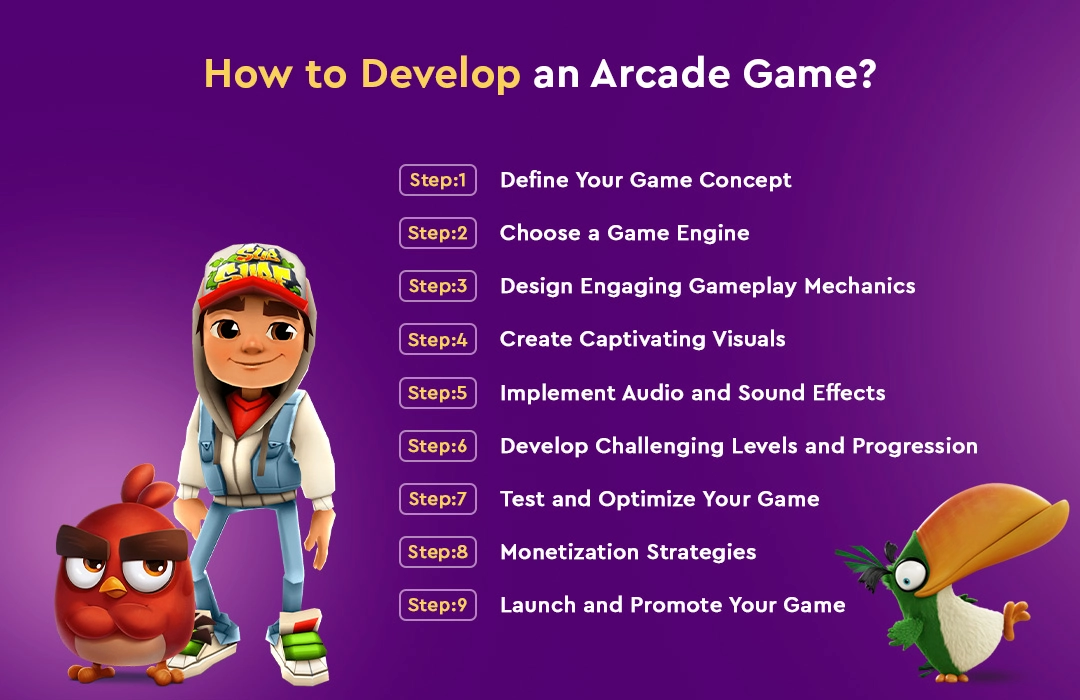
1. Define Your Game Concept
The first step in developing a mobile arcade game is to define your game concept. Consider the genre, gameplay mechanics, target audience, and overall theme of your game. This initial planning stage will lay the foundation for the entire development process. Before opting for arcade game development services, you should make sure that the concept is clear and concise. Make sure your concept aligns with the target audience so that you can reach them more effectively.
2. Choose a Game Engine
Selecting a suitable game engine is crucial for the development of your mobile arcade game. Popular game engines such as Unity and Unreal Engine provide powerful tools and resources to streamline the development process. Evaluate different engines based on your project’s requirements and choose the one that best fits your needs.
3. Design Engaging Gameplay Mechanics
The success of any arcade game lies in its gameplay mechanics. Design innovative and engaging mechanics that keep players hooked. Incorporate elements such as power-ups, level progression, leaderboards, and intuitive controls to enhance the overall gaming experience. With a professional mobile game development company, you can create unique and entertaining mechanics for your game.
4. Create Captivating Visuals
Invest time in designing captivating visuals that align with your game’s theme and target audience. Pay attention to color schemes, character designs, backgrounds, and special effects to create a visually stunning game.
5. Implement Audio and Sound Effects
Audio is an essential component of any game, as it enhances immersion and creates a captivating atmosphere. Incorporate engaging sound effects and background music that complement the gameplay and contribute to the overall experience. Consider collaborating with a sound designer or exploring royalty-free music libraries for high-quality audio assets.
6. Develop Challenging Levels and Progression
To keep players engaged, it’s crucial to develop challenging levels and a progressive difficulty curve. Design levels gradually increase in complexity, offering new obstacles and rewards along the way. Balancing the difficulty ensures both casual and hardcore gamers find enjoyment in your mobile arcade game.
7. Test and Optimize Your Game
Thorough testing is vital to identify and resolve bugs, glitches, and performance issues. Conduct extensive playtesting sessions to gather feedback and make necessary adjustments. Optimize your game for different mobile devices, screen sizes, and resolutions to ensure a smooth and enjoyable user experience.
8. Monetization Strategies
Consider implementing monetization strategies to generate revenue from your mobile arcade game. Explore options such as in-app purchases, advertisements, or premium versions to monetize your creation. Strike a balance between providing value to players and generating income to support ongoing development and maintenance.
9. Launch and Promote Your Game
Once your mobile arcade game is polished and ready, it’s time to launch and promote it. Create compelling visuals and descriptions for your app store listings, engage with potential players through social media, collaborate with influencers, and consider running targeted ad campaigns to maximize visibility and downloads.
Before you hire game developers and start building your arcade game, it’s important to understand how long it takes to create an arcade game.

How Long Does It Take to Build an Arcade Game?
Depending on the complexity and scope of your project, building a mobile arcade game could take anywhere from 6 to 8 months. Factors that affect development time include the size of your team, the number of features and levels you plan to incorporate, and any additional technology requirements. Make sure to discuss your timeline with arcade game developers before signing an agreement. Now, let’s check out the factors affecting the overall cost of building the arcade game.
Factors Affecting the Cost of Creating an Arcade Game
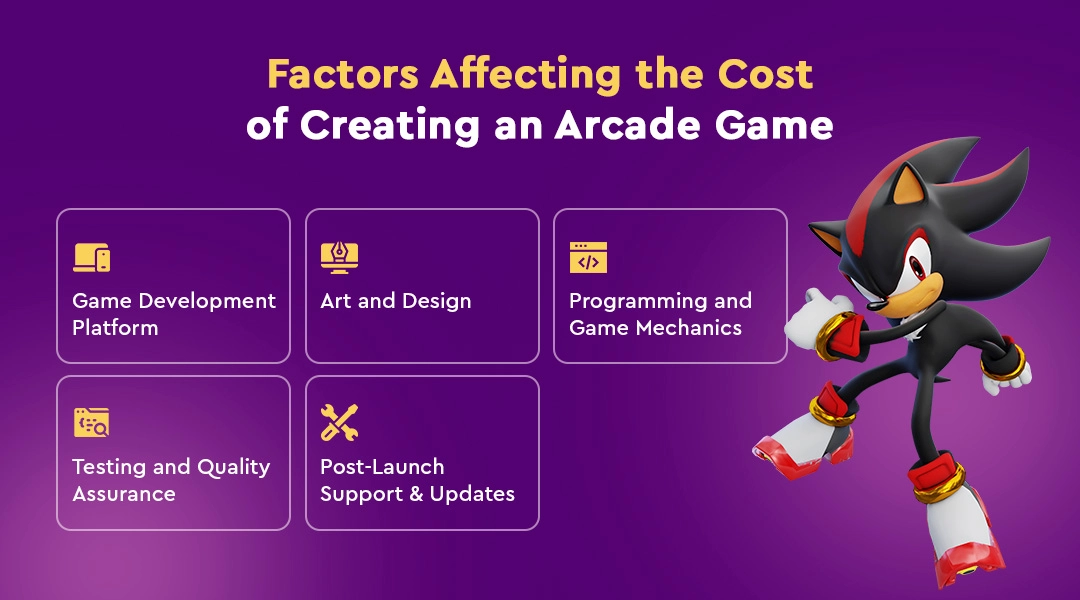
1. Game Development Platform
The choice of the game development platform significantly affects the overall cost. Different platforms require different software tools and programming languages, leading to variations in development time, complexity, and associated costs. Options include popular platforms like Unity, Unreal Engine, and custom-built solutions.
2. Art and Design
The visuals and design of arcade gameplay play a crucial role in attracting players. The complexity and quality of the artwork, character design, animations, and 3D modeling directly impact the cost. Hiring skilled artists or outsourcing artwork can increase expenses while using existing assets or opting for simpler designs can help reduce costs.
3. Programming and Game Mechanics
Developing the core functionality and game mechanics involves coding and scripting. The intricacy of gameplay, artificial intelligence, physics simulations, and user interactions influence the development time and cost. More intricate mechanics and advanced features often require skilled programmers, leading to higher expenses.
4. Testing and Quality Assurance
Ensuring a smooth and bug-free gaming experience is essential for player satisfaction. Extensive testing, including debugging, performance optimization, and compatibility checks across different devices and operating systems, adds to the development cost. Employing dedicated testers or outsourcing testing services helps maintain game quality but may increase expenses.
5. Post-Launch Support and Updates
Continued support and updates after the game’s release are essential for maintaining player engagement and addressing any issues. These ongoing expenses include customer support, bug fixes, content expansions, and compatibility updates for new devices or operating system versions.
Now, let’s come to the main aspect — What is the cost of arcade game development solutions?
How Much Does It Cost To Develop an Arcade Game?
The cost of developing an arcade game depends on the complexity, features, and platforms it supports.
Developing an arcade game with basic MVP features may cost between $20k to $40k depending on the development approach. If you want to develop a game with additional features and functionality, it can cost anywhere from $40k to $75k or more. To obtain a detailed estimate for developing an arcade game as per your requirements, please don’t hesitate to reach out to our experts.
Arcade games that require extensive artwork and graphics may be more expensive due to extra costs associated with hiring skilled artists or outsourcing artwork services.
Bonus Point: Strategies for Reducing Arcade Game Development Cost
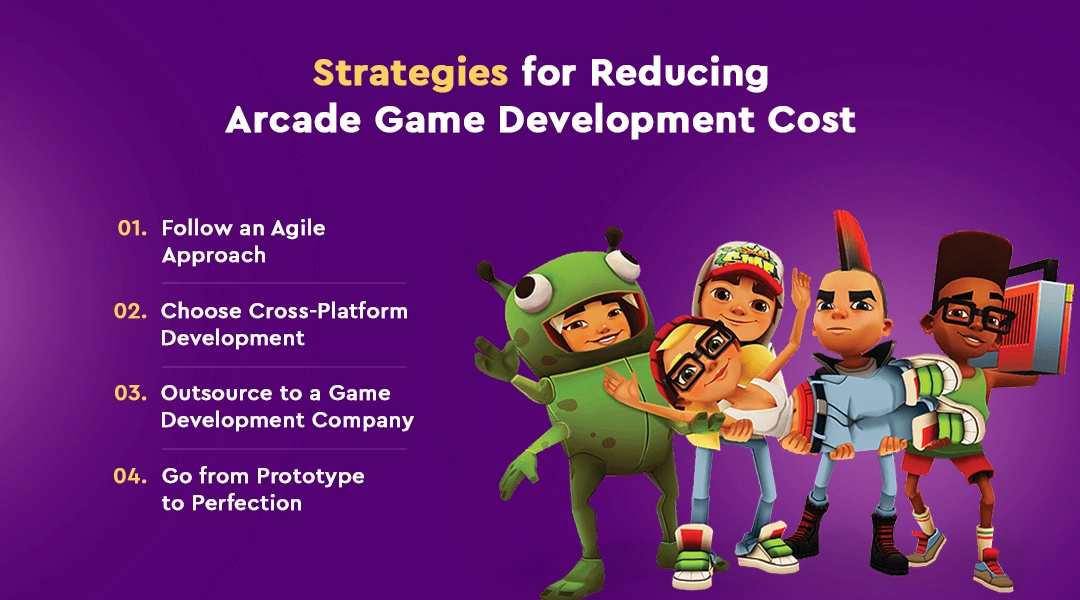
1. Follow an Agile Approach
Agile methodologies, such as Scrum or Kanban, provide a structured framework for managing game development projects. The iterative nature of agile development allows for flexibility, adaptability, and effective collaboration within the development team. This approach promotes cost reduction by enabling quick adjustments based on feedback, reducing the risk of costly rework.
2. Go from Prototype to Perfection
By starting with a prototype, developers can validate game mechanics, core features, and user experience before investing in full-scale development. Prototyping enables early detection of flaws and improvements, minimizing the likelihood of costly revisions during later stages. This approach saves time and resources by focusing efforts on developing a polished and engaging final product.
3. Outsource to a Game Development Company
Consider outsourcing the development process to a specialized game development company. Outsourcing tasks such as art asset creation, sound design, or quality assurance can help reduce costs in the long run. Game development companies have the expertise and resources to deliver high-quality work efficiently while allowing your core team to focus on critical aspects of the game.

4. Choose Cross-Platform Development
Developing games for multiple platforms can be a costly endeavor. By utilizing cross-platform development frameworks such as Unity or Unreal Engine, you can significantly reduce costs. These frameworks enable developers to create games that can run on various platforms with minimal adjustments, saving both time and resources.
By implementing these strategies, game developers can effectively reduce arcade game development costs without compromising on quality. Moreover, working with a professional arcade game development company like Auxano Global Services will help you gain an edge with its efficient development process.
Wrapping up!
Developing arcade games can be a daunting process, but with the right strategy and approach, you can minimize costs while ensuring that your game is of the highest quality. As the trend of digital gaming continues to grow, it’s the right time to build your own game. With the help of experienced game development professionals and advanced technology, you can confidently create a successful game that stands out in today’s competitive market.
Frequently Asked Questions
-
1. What factors determine the cost of developing an arcade game?
The cost of developing an arcade game depends on various factors such as game complexity, graphics and art style, platform compatibility, audio design, and additional features like multiplayer options or in-app purchases.
-
2. Are there any ballpark figures for the cost of arcade game development?
It is challenging to provide an exact cost without specific project details but arcade game development costs can range between $20,000 to $75,000. To know the exact cost of developing an arcade game as per your requirements, feel free to contact our experts for a detailed price estimation.
-
3. How does the complexity of the game affect the development cost?
The complexity of an arcade game significantly impacts the development cost. Games with intricate gameplay mechanics, advanced graphics, and sophisticated AI systems require more time and effort from developers, which can drive up the overall cost.
-
4. Can choosing a particular platform influence the cost of arcade game development?
Developing a game for a single platform, such as Android or iOS, might be expensive compared to targeting multiple platforms simultaneously. Each platform may have different technical requirements and development processes, which can impact the overall cost.
-
5. Are there any ongoing costs after the initial development of an arcade game?
Yes, there are ongoing costs associated with maintaining and supporting an arcade game. These costs include server hosting, regular updates and bug fixes, marketing and promotion, customer support, and potential expansion packs or downloadable content (DLC) development.



![Outsource Game Development [Complete Guide 2023]](https://www.auxanoglobalservices.com/agsresources/wp-content/uploads/2023/06/Outsource-Game-Development-Complete-Guide-2023.jpg)
